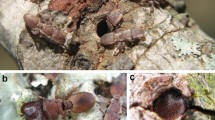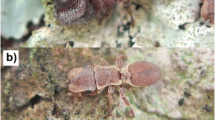Summary
The developmental pathways of the neuter castes were studied in three species of Nasutitermitinae from central Panama. The humivorousSubulitermes denisae andCoatitermes clevelandi display several primitive traits: absence of sex dimorphism, representation of both sexes among workers and soldiers, and occurrence of successive worker instars. The litter-dwellingVelocitermes barrocoloradensis has a more complex caste system: female larvae are larger than males and give rise to the large workers, which constitute the bulk of the work force; male larvae proceed to soldiers through a small worker or a special larval instar. The resulting soldier caste is polymorphic. These results support previously formulated hypotheses regarding a link between humivorous diet and reduced polymorphism on the one hand, and between forest-floor foraging and large continuous size variation among soldiers on the other. Whereas the caste systems ofSubulitermes andCoatitermes probably represent a primitive condition,Velocitermes shares derived traits withNasutitermes and the other fully nasute genera previously studied. I therefore hypothesize that ancestors with these advanced features may have spread from the neotropics and be at the origin of most nasute genera, including humivorous taxa, present in other regions.
Similar content being viewed by others
References
Ahmad, M., 1950. The phylogeny of termite genera based on imago-worker mandibles.Bull. Amer. Mus. Nat. Hist. 95:37–86.
Constantino, R., 1995. Revision of the neotropical termite genusSyntermes Holmgren (Isoptera: Termitidae).Univ. Kans. Sci. Bull. 5:455–518.
Deligne, J., 1966. Caractères adaptatifs au régime alimentaire dans la mandibule des termites (Insectes Isoptères).C. R. Acad. Sci. Paris 263:1323–1325.
Fontes, L. R., 1982. Novos táxons e novas combinações nos cupins nasutos geófagos da região Neotropical (Isoptera, Termitidae, Nasutitermitinae).Rev. Bras. Entomol. 23:219–227.
Fontes, L. R., 1987a.Cupins neotropicais da subfamília Nasutitermitinae (Isoptera, Termitidae); morfologia do soldado e das mandíbulas do alado e operário, anatomia do tubo digestivo do operário e filogenia dos gêneros. PhD dissertation, Universidade de São Paulo, Brazil. 142 pp.
Fontes, L. R., 1987b. Morphology of the alate and worker mandibles of the soil-feeding nasute termites (Isoptera, Termitidae, Nasutitermitinae) from the Neotropical Region.Rev. Bras. Zool. 3:503–531.
Fontes, L. R., 1987c. Morphology of the worker digestive tube of the soil-feeding nasute termites (Isoptera, Termitidae, Nasutitermitinae) from the Neotropical Region.Rev. Bras. Zool. 3:475–501.
Mathews, A. G. A., 1977.Studies on termites from the Mato Grosso State, Brazil. Academia Brasileira de Ciências, Rio de Janeiro, Brazil. 267 pp.
Miller, L. R., 1986. The phytogeny of the Nasutitermitinae (Isoptera: Termitidae).Sociobiology 11:203–214.
Noirot, C., 1955. Recherches sur le polymorphisme des termites supérieurs (Termitidae).Ann. Sci. Nat. Zool. (11e sér.) 17:399–595.
Noirot, C., 1969. Formation of castes in the higher termites. In:Biology of Termites — Vol. 1 (K. Krishna and F. M. Weesner, Eds.), Academic Press, New York. pp. 311–350.
Noirot, C., 1982. La caste des ouvriers, élément majeur du succès évolutif des termites.Riv. Biol. 75:157–195.
Noirot, C., 1989. Social structure in termite societies.Ethol. Ecol. Evol. 1:1–17.
Noirot, C., 1992. From wood- to humus-feeding: an important trend in termite evolution. In:Biology and Evolution of Social Insects (J. Billen, Ed.), Leuven University Press, Leuven, Belgium, pp. 107–119.
Prestwich, G. D. and M. S. Collins, 1981. Chemotaxonomy ofSubulitermes andNasutitermes termite soldier defense secretions. Evidence against the hypothesis of diphyletic evolution of the Nasutitermitinae.Biochem. Syst. Ecol. 9:83–88.
Roisin, Y., 1992. Development of non-reproductive castes in the neotropical termite generaCornitermes, Embiratermes andRhynchotermes (Isoptera, Nasutitermitinae).Ins. Soc. 39:313–324.
Roisin, Y., 1995. Humivorous nasute termites (Isoptera: Nasutitermitinae) from the Panama Canal area.Belg. J. Zool. 125:283–300.
Sands, W. A., 1965. A revision of the termite subfamily Nasutitermitinae (Isoptera, Termitidae) from the Ethiopian Region.Bull. Brit. Mus. (Nat. Hist.) Ent. Suppl. 4:1–172.
Author information
Authors and Affiliations
Rights and permissions
About this article
Cite this article
Roisin, Y. Castes in humivorous and litter-dwelling neotropical nasute termites (Isoptera, Termitidae). Ins. Soc 43, 375–389 (1996). https://doi.org/10.1007/BF01258410
Received:
Revised:
Accepted:
Issue Date:
DOI: https://doi.org/10.1007/BF01258410




